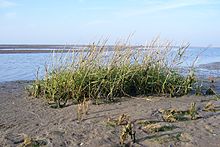This article includes a list of general references, but it lacks sufficient corresponding inline citations. (July 2014) |
| Sporobolus anglicus | |
|---|---|

| |
| Scientific classification | |
| Kingdom: | Plantae |
| Clade: | Tracheophytes |
| Clade: | Angiosperms |
| Clade: | Monocots |
| Clade: | Commelinids |
| Order: | Poales |
| Family: | Poaceae |
| Genus: | Sporobolus |
| Species: | S. anglicus
|
| Binomial name | |
| Sporobolus anglicus | |
| Synonyms | |
| |
Sporobolus anglicus (common cordgrass[1]) is a hybrid-derived species of cordgrass that originated in southern England in about 1870 and is a neonative species in Britain.[2] It was reclassified as Sporobolus anglicus after a taxonomic revision in 2014,[3] but Spartina anglica is still in common usage.[4]: 1119 It is an allotetraploid species derived from the hybrid Sporobolus × townsendii, which arose when the European native cordgrass Sporobolus maritimus (small cordgrass) hybridised with the introduced American Sporobolus alterniflorus (smooth cordgrass).[2][4]
It is a herbaceous perennial plant growing 0.4–1.3 metres (1–4 ft) tall, yellowish green in spring and summer, and turning light brown in autumn and winter. The leaves are 20–60 centimetres (8–24 in) long, and 1.5 centimetres (1⁄2 in) broad at the base, tapering to a point. It produces flowers and seeds on only one side of the stalk. The flowers are a yellowish-green, turning brown by the winter.
- ^ BSBI List 2007 (xls). Botanical Society of Britain and Ireland. Archived from the original (xls) on 2015-06-26. Retrieved 2014-10-17.
- ^ a b Cope, Tom; Gray, Alan (2009). Grasses of the British Isles: BSBI Handbook No.13. Botanical Society of Britain and Ireland. ISBN 978-0-901158-420.
- ^ Peterson, PM , et al (2014) A molecular phylogeny and new subgeneric classification of Sporobolus (Poaceae: Chloridoideae: Sporobolinae), Taxon 63: 1212-1243.
- ^ a b Stace, Clive (2019). New Flora of the British Isles (4 ed.). C & M Floristics. ISBN 978-1-5272-2630-2.